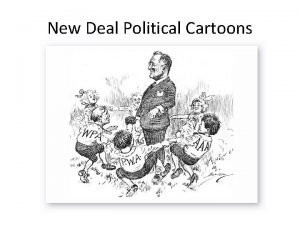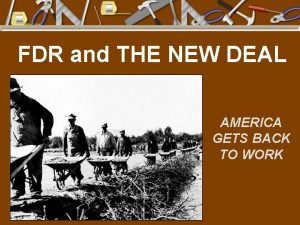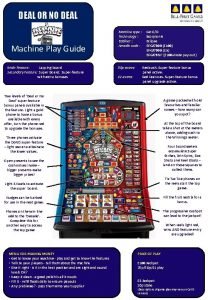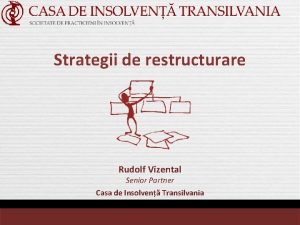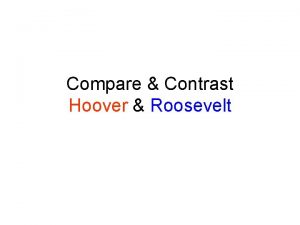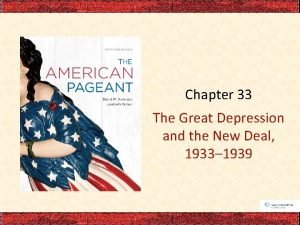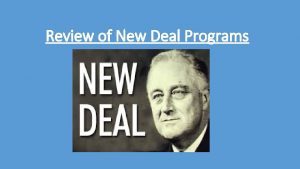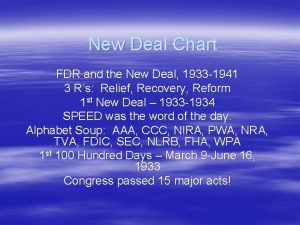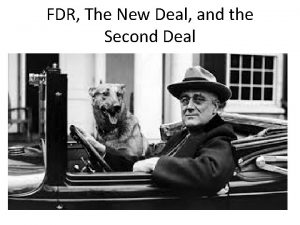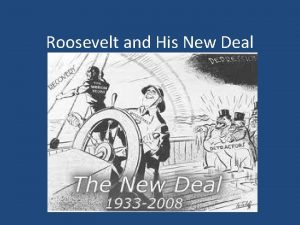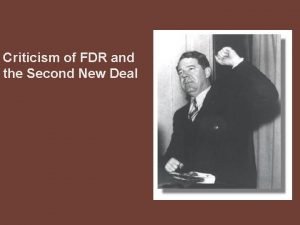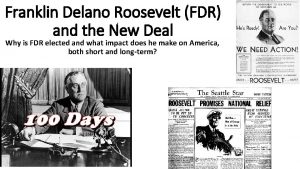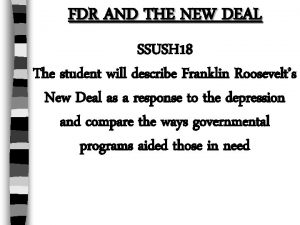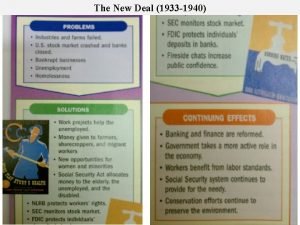FDR and the New Deal FDR Wins the












- Slides: 12

FDR and the New Deal

FDR Wins the Presidency • We talked last time about the election of 1932 • FDR won in a landslide! • He promised a “New Deal for the American people” • After Hoover’s failure to act…… people wanted their leaders to do something!

New Deal – First 100 Days • Roosevelt said in his Inaugural Address, “let me assert my firm belief that the only thing we have to fear is fear itself. . This nation asks for action, and action now!” • Roosevelt immediately began to submit a flood of measures for Congressional approval. This became know as the “Hundred Days” • Virtually all of the important bills he submitted in these First Hundred Days were enacted by Congress.

New Deal – First 100 Days • Roosevelt explained these New Deal measures in terms of the three R's -- Relief, Recovery, and Reform • Sometimes called “alphabet agencies” because of their 3 and 4 letter acronyms

New Deal rograms – Relief • Public Works administration (PWA) • Created federal jobs by building projects like schools. Roads, and bridges. • Civilian Conservation Corps (CCC) • gave jobs to young men (lived in camps and received free food)

New Deal Programs - Recovery • National Recovery Administration (NRA) • Limits on production, set prices, and minimum wage • Agricultural Adjustment Acts (AAA) • Paid farmers to plan less crops

New Deal Programs – Reform • Tennessee Valley Authority (TVA) • Built 21 dams in Tennessee for flood control and produce electricity • Securities and Exchange Commission (SEC) • Watched over stock market

Gold Standard • Gold and Silver was the two accepted forms of exchange. The gold standard = gold and silver to back up currency • In 1933 President Roosevelt issued an Executive Order outlawing the ownership of gold, except for jewelry (Ended the Gold Standard) • Roosevelt wanted people to rely on paper money (fiat money), in order to expand the money supply and stimulate economic activity. • Today, most countries in the world, including the United States, use fiat money. • It has no intrinsic value, except when it is accepted as a medium of exchange.

Opposition to New Deal • The first series of programs, sometimes called the first new deal, created some jobs, but did not have a big effect. • Only two years into his presidency Roosevelt remained popular but grew critics and was unhappy with progress. • People like Huey Long from Louisiana didn’t think it went far enough and wanted to give everyone $5, 000. 00 a year by taking the rich. He called it his “share the wealth” program • The American Liberty League was a group of conservatives who felt the New Deal was destroying America.

Opposition to New Deal • Dr. Townsend – a third party candidate - wanted to give people over 60 …. . $200. 00 a month. • Because he felt pressure from the left and right Roosevelt launched more programs …. . Called the second New Deal. • Works Progress Administration (WPA) • Created jobs by hiring artists, writers, and musicians to create art, produce plays, etc. • Social Security Act • Unemployment insurance, pensions (retirement), insurance

Supreme Court – Court Packing • In 1935/36 the Supreme Court declared some New Deal programs unconstitutional. • So in 1937 Roosevelt feared the court might declare more of his programs unconstitutional. • He felt most of the justices, who were all over 70, were out of touch. • He proposed a plan that would allow a president to appoint a new justice for each justice over 70 years old. • This would have let Roosevelt appoint 6 new justices. • It was seen as a danger to the separation of powers and rejected by congress.

The New Deal Legacy • The New Deal marked an end to the view that government and the economy should be completely separate. • People now looked to the federal government for assistance. • The New Deal also permanently increased the size and power of the federal government.
 How the south interprets the new deal
How the south interprets the new deal Nlra poster
Nlra poster Deal or no deal machine
Deal or no deal machine Rudolf vizental
Rudolf vizental Fdr and hoover compare and contrast
Fdr and hoover compare and contrast The great depression vocabulary
The great depression vocabulary New deal political cartoons and explanations
New deal political cartoons and explanations What is the main idea of this cartoon?
What is the main idea of this cartoon? Chapter 33 the great depression and the new deal
Chapter 33 the great depression and the new deal New deal alphabet soup
New deal alphabet soup The new deal affects many groups chapter 15 section 3
The new deal affects many groups chapter 15 section 3 Apush new deal
Apush new deal Aaa new deal logo
Aaa new deal logo
